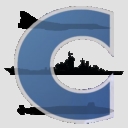gosnold
Posts: 233
Joined: 7/10/2013
Status: offline

|
quote:
ORIGINAL: ExNusquam
Gosnold, this is easily one of the best open-source pieces on Chinese space based ISR, and the implications of that for building a firing solution. I fully concur with you that there are two targeting windows, where there are closely spaced passes by a SAR bird followed by an EO bird. I only have a couple of minor technical points:
1. You asses that if the SAR birds flew in pairs they could do positive ship ID. I doubt this is possible beyond basic dimensions and RCS due to the effects of target motion on SAR. A moving target will be a blurry, smeary mess at high resolution and a slightly less blurry, smeary mess at lower resolution. The streaking in the example of the oil tanker (left) is caused by the relatively small motion of the ships radars; I suspect the ship itself is stationary.
2. I have suspicions about the ability of the GF-4 to effectively track BLUFOR ships. Here's a screenshot from MarineTraffic showing AIS hits just North of the Marianas (inside the second island chain)...there are a lot of vessels out there that will generate sizable wakes. A 50m EO GSD means a Carrier will be 6 piles on a GF4 image, which is likely not enough to ID. The 400m IR GSD probably won't be much use. The GF4 is an ocean surveillance system, and will likely be used to gauge activity levels, but I doubt it can do the independent tracking that is often claimed.
3. I also think that cloud cover is a huge limitation on EO coverage. It's cloudy a lot in the Pacific. Here's the current aviation sigwx forecast, and you can see that there's typically a decent amount of cloud cover across the entire region.
Thanks for the feedback!
Regarding 1., I did not know moving targets are blurry on SAR images, but I looked it up and you are right, the high-resolution images of a fast ship would be deteriorated, making identification more difficult. Now SAR processing is kind of a black art and there might be ways to get rid of the blur if you really need to, so I wouldn't say ship moving ship ID is impossible with SAR.
For 2., I think carrier identification is very feasible with GF-4. If you look for a 330m-long CVN, you are looking for ships 6 to 7 pixels long. That means 300 to 350m, so you have aircraft carriers, oil supertankers and large container ships. The GF-4 sensor gives you colour + IR so you can ignore the ships that are not gray, that reduces the number of candidates considerably. Then you can discriminate on speed: the tankers and container ships rarely go over 20 knots, the carrier is the only one that can go 30 knots. Finally you can discriminate on course: the civilian ships will follow a constant heading, the carrier will change heading to have head-on winds during air operations. With all that I don't think you can mistake the carrier and the civilian ships.
Regarding 3., you are definitely right about that, cloud coverage has a major impact. Do you know a good resources to know cloud coverage over the course of a year? I'm looking for how much time the weather is completely overcast for several days at a time in the region, since that would make optical systems blind.
|
 Printable Version
Printable Version
















 New Messages
New Messages No New Messages
No New Messages Hot Topic w/ New Messages
Hot Topic w/ New Messages Hot Topic w/o New Messages
Hot Topic w/o New Messages Locked w/ New Messages
Locked w/ New Messages Locked w/o New Messages
Locked w/o New Messages Post New Thread
Post New Thread